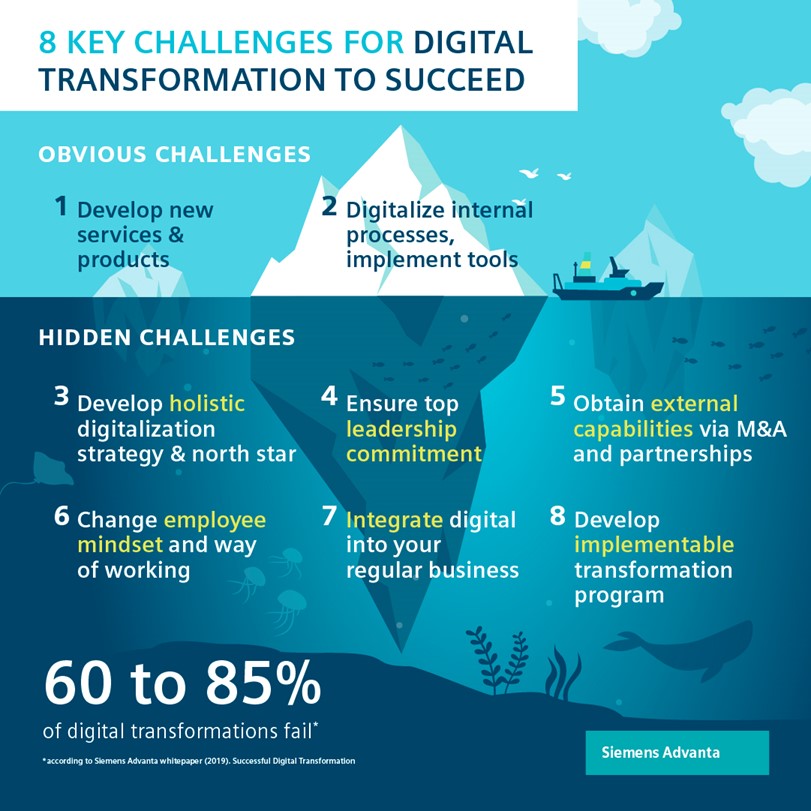
Eight Key Challenges for Digital Transformation to Succeed

According to the Harvard Business Review, Siemens is among the top global players for digital transformation along with firms such as Amazon, Netflix, Microsoft, and Intuit, to name just a few. Since the dawn of the digital age, Siemens has been at the forefront of digital automation, vertical software leadership, and, more recently, the Internet of Things (IoT). This means that as an organization, Siemens offers unique insights into the challenges that need to be met for digital transformation to succeed, because the company already stumbled over several roadblocks itself. If digital transformation strategies are not put in place, or enacted poorly, then companies will fail. After all, around half of Fortune 500 companies have disappeared since 2000. The same fate could befall any organization that fails to meet the challenges for digital transformation today. What are they, and why are some not as obvious as others?
Obvious business challenges of digital transformation
First, it will be best to look at some of the most obvious business challenges with digital transformation. They are a good benchmark of what every organization will need to overcome to succeed in the digital future. They are also a good starting point to think about digital transformation before the less obvious challenges start to become more evident.
One – Developing new services and products
Perhaps the most obvious of all challenges for digital transformation involves identifying new services and products to support a business's core portfolio. New customer demands force businesses to develop new products and services. However, companies often struggle to find the right solutions that fit their original business strategy and product portfolio. To take a highly successful example, Netflix began as a DVD and Blu-ray rental-by-mail firm in 1998, a service it still offers. Netflix's commitment to digital transformation in the 2000s meant it initially offered an online ordering system for its physical products. Soon, however, it had completed its digital transformation into one of the world's most popular digital streaming services, not just offering on-demand access to its customers but producing exclusive content for it as well. New business models that go beyond the traditional core business, such as Anything as a Service (XaaS), can be one digitally enabled evolution for a traditional business. A holistic data strategy can support the evaluation of the value of data for a business and identify new untapped business potentials.
Two – Digitizing internal processes and new tool implementation
Another quite obvious business challenge with digital transformation addresses the goal to optimize internal processes and procedures. While the development of new digital products and services is very much outwardly focused, transforming processes are about focusing on internal structures. In many organizations, this might boil down to adapting internal processes so that they can function in a newly implemented digital environment. This might mean, for example, analyzing where exchanging traditionally used tools to digital ones will work, such as human resources (HR) tools. For instance a digitized self-service portal for booking leave or assigning availability for shifts could make it much easier to track worker numbers in real-time rather than relying on old-fashioned paper-based systems.
Equally, leveraging customer data to simplify and accelerate business processes can help firms to run more efficiently. For example, Artificial Intelligence (AI) systems might be deployed in manufacturing businesses to ensure supply chains are one step ahead of the game. AI-driven sales forecasting might help with inventory and financial planning, but it could also inform buyers that they'll need to order certain components to meet future orders even before they are done deals. In short, process automation is about operating with less wastage and greater efficiency, something that affects every company's bottom line. However, not every process should and can easily be digitalized. The secret lies in identifying the right areas and tools in which digitalization provides value not only to the organization itself but also to its customers.
Digital transformation key challenges that are more hidden
There are also some less obvious challenges organizations need to face today during their digital transformation. Although many digital transformation challenges faced by organizations and their potential solutions are, in fact, relatively clear, some might not be. What are those hidden challenges, and why are they sometimes not so easy to identify within certain organizations?
Three – Developing a holistic digitization strategy and north star
Today, every digital transformation strategy needs to be based on a holistic digital approach that does not play around on the sideline. By adding a 'off-the-shelf' digital offering here or there, some organizations might feel as though they have done enough to adapt to the digital age. However, it is only by adopting a comprehensive strategy that true transformation will be achieved. Of course, any transformation, digital or not needs to fit the overall business strategy. Otherwise, business goals will not be achieved. This doesn't mean that everything other than a root-and-branch adoption of digital technologies will be enough if an organization wants to succeed. This means that its core business, as well as its organizational structures, processes, and technologies, need to be part of the transformation strategy.
Think of it like following the north star in the night sky. Although there might be a lot of change happening around it, progress in one direction is possible by sticking with the fixed point in the distance. This is why a holistic approach is often less obvious to organizations that want to change. Many will try to alter one or two things and question why a more comprehensive approach is needed at all. However, unless digital technologies are deployed throughout the organization, from the business management team to the people and organizational structure as well as the operational processes, competitors are likely to outperform further down the line. In short, for digital transformation to work, it needs to be truly transformative in every aspect.
Four – Gaining the commitment of top leaders
In fairness, digital transformation leadership challenges come in many forms. The most essential one to grasp will be gaining the commitment of business decision-makers to go about transformational change. Unless the management team is on board with a holistic approach to organizational transformation, it will be much harder to achieve the desired outcomes. In other words, the key decision-makers need to be committed to all of the initiatives that will form the digitization strategy. Even more crucial, they'll need to see it as their highest business priority.
For those driving digital transformation from below, keeping the top management on board is vital. Therefore, chief information officers will need to continue extolling the virtues of digital transformation in commercial terms. Once digital transformation begins, there should be no turning back or wavering among the top level of management. Equally, company bosses need to foster enthusiasm among their middle management teams if the project is to come to fruition in a timely manner. Business owners will need to ensure they have the buy-in of lower management levels as well as ordinary employees. Sometimes appointing champions or ambassadors of digital change can make all the difference in ensuring this sort of buy-in occurs.
Think of it like following the north star in the night sky. Although there might be a lot of change happening around it, progress in one direction is possible by sticking with the fixed point in the distance.
Five – Obtaining external capabilities by strengthening your partnerships and ecosystem
The next hidden challenge that needs to be met is how to obtain the external capabilities you'll need for your organizational transformation to succeed by leveraging your partner ecosystem. Some organizations will have some of the digital competencies they will need to transform in-house already. Others won't. Therefore, you need to understand your own core competences first and complete it with strong partnerships afterwards as even the largest organizations cannot do it alone. Regardless of the number of recruits an organization takes on board to complement its current skillset, outside partners will need to be brought in as well. This may mean a transformation in management culture too, of course, if the organization in question is not used to outsourcing some of its key processes. There are alternative strategic approaches some organizations might also like to consider. For example, companies don't always need to outsource to secure the capabilities to strengthen their ecosystem. Instead, they could look at joint ventures with partner businesses or even analyze their options with regards to mergers and acquisitions. If the skills a business needs are already abundant in a competitor, it might be worth considering to adapting it.
Six – Altering employee mindsets and ways of working
Although it is fair to say that systems, processes, and managerial buy-in are all crucial to meeting the challenges of digital transformation, there is something else businesses need to consider: people. After all, it is people who will be at the core of any successful digital transformation exercise. Unless your own staff gets on board with the concept and understands its benefits from a very early stage, it will not be the success it could be. What does this mean in practical terms, though? To begin, education is at the core of explaining why a digital transformation strategy will be better for the strength of the organization as a whole. People may feel threatened by adopting a new way of working or of increasing automation, potentially putting them out of work. However, if they are taught to realize that without a digital transformation process, the business does not have a viable future, then they'll soon come to understand why such change is needed. In other words, they need to realize that digital transformation is in their best interest and beneficial for all stakeholders.
Organizations can create better awareness about digital transformation by being open about the process. Secrecy rarely helps in meeting the challenge of persuading people about this sort of transformation. As transformation plans begin to roll out, organizations will want to alter their employee's mindsets. This won't happen unless staff members feel empowered with the digital tools they're now expected to use. In short, it means investing in high-quality employee training so staff can adapt to the new way of working. In some cases, decentralizing decision-making to a departmental level can help people to feel more in control of the change process. Agile ways of working may be introduced thanks to digital technology, but it may still take a period of adjustment to ensure full commitment. People still often want human interaction when they're at work, so it's important to give employees time to adjust their mindsets and habits. The bottom line is that employee buy-in is crucial. Therefore, without educating your people about the new technologies and processes they'll be expected to use, your transformation simply won't work.
Seven – Keeping hold of the ownership of business digitization
In short, digital transformation needs to be driven by the corporate decision-makers themselves. It is not a project that leaders can fully delegate to their business units, IT department or regions. The responsibility can’t lie with a single department but needs to be realized cross-departmentally to avoid silo thinking, power struggles, following departmental goals and losing the overall picture. The transformation will alter every aspect of the organization, not just specific business areas, products, or functions. Equally, there is no one-size-fits-all transformation process businesses can purchase off-the-peg. Every step along the way needs to be tailored not only to the whole organization involved but also to the individual business. Every business needs to take care of adapting the corporate initiatives to their individual needs.
Eight – Developing an implementable transformation program
Finally, it is insufficient to have a theoretical framework for digital transformation alone. Organizations can plan ahead, but what they'll actually need is something concrete that can be fully implemented. Therefore, a holistic program for digital transformation is needed. A key challenge for all organizations, both large and small, is to have a program that is not only far-reaching but also realistic at the same time. The program needs to be adaptable to any changes in real-world situations. Business priorities might change as the digital transformation program is underway. Setting up trackable key performance indicators (KPIs), overarching goals, and other measures is essential to keep track of progress. It is also fundamental to identify lighthouses, namely already running and successful projects and blueprints as best practices to set an example for all parts of the organization.
Overcoming digital transformation challenges in large and complex organizations
Digital transformation should not be done for its own sake. Organizations that do not follow their business imperatives on their journey will not see successful outcomes. All business transformation projects need to be adapted to their individual organizational needs and digital transformation is no exception to this rule.
Although kicking off a digital journey is unique, the challenges identified above are key to every commercial enterprise and organization when it comes to digital transformation, regardless of its core business. However, some companies will face further challenges specific to their region or sector. Of course, identifying the key obstacles to success is one thing, but doing something about them is another.
The factors that will help large and complex organizations to overcome these challenges are also varied. Key among them is the integrative and multi-dimensional approach that should be taken throughout the organization. This must be based on a holistic strategy, because scratching at the organization’s surface will not be sufficient to drive real change. Accepting that there will be resistance to transformational change, especially at the beginning of the project, will be of huge benefit. Organizations that try to force the pace of change or that make too many demands of employees tend to suffer.
That is not to say that digital transformation projects should not be ambitious. The transformation will require organizations to challenge every aspect of their processes, technologies, and structure. The key is momentum. Once change is happening, keep the ball rolling and don't let it stop. You don't need a wrecking ball approach, however. Think big but start small. All organizations will find there is better buy-in from stakeholders once the proof of concept surrounding the strategy has been established. Therefore, even small early wins can have a big impact on change down the line. In many situations, a strong partner company is all that is needed to tackle the initial challenges, as well as the harder ones that businesses will sometimes face as the pace of change picks up.
Our expert




 Contact Us
Contact Us